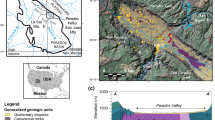Abstract
An airborne electromagnetic survey was flown over 13 000 km2 in the Lower Macquarie Valley in central New South Wales, Australia. Whilst bulk conductivity values from the survey provide useful insights into the regional hydrogeology of the area, mapping salinity and salinity hazards requires the derivation of salt store values from the survey data. This paper describes the methodology of deriving salt stores from conductivity data and accompanying physical measurements. A post-flight sampling programme involving physical, chemical, electromagnetic and geological examination of cores from eight drill holes provides field-based measurements through which the bulk conductivity data can be related to salt stores. Linear models were generated to understand the relationship between salt stores, conductivity and other parameters, and to produce an optimum salt store map from the data. A strong relationship was evident between observed salt stores and drill hole-derived observations, which include parameters such as conductivity, lithology, stratigraphy, lithostratigraphy/weathering and depth. The main predictor for salt stores was observed conductivity with only a minor influence due to lithology. Significant salt stores are predicted at depth in the northern part of the survey. Superficial salt stores are generally low (<4 kg/m3) in the Lower Macquarie and should not pose a threat to native vegetation or agricultural activities.












Similar content being viewed by others
References
Cresswell RG, Dent DL, Jones GL, Galloway DS (2004) Three-dimensional mapping of salt stores in the southeast Murray-Darling Basin, Australia 1. Steps in calibration of airborne electromagnetic surveys. Soil Use Manag 20:133–143
Cresswell RG, Mullen IC, Kingham R, Kellett J, Dent DL, Jones GL (2007) Airborne electromagnetics supporting salinity and natural resource management decisions at the field scale in Australia. Int J Appl Earth Obs Geoinf 9(2):91–102
Haman DZ (2005) Irrigating with high salinity water. BUL322 Agricultural and Biological Engineering Department, Florida Cooperative Extension Service, Institute of Food and Agricultural Sciences, University of Florida. http://edis.ifas.ufl.edu. 5 p
Hone I, Macaulay S, Palamara DR (2008) Mapping groundwater resources of the Lower Macquarie Catchment of NSW (Australia) using airborne electromagnetics. Eos Trans. AGU, vol 89, no 23, West Pac Geophys Meet Suppl (abstract H21A-04)
Kellett J, Mullen I, Mansfield D, Spring J (2006) Drilling and geophysical logging for design of airborne electromagnetic survey in the lower Macquarie Valley, New South Wales, Australia. Bureau of rural sciences report, 91 p
Kellett J, Mullen I, Mansfield D, Spring J, Frost M (2008) Drilling, coring and geophysical logging for calibration of airborne electromagnetic survey in the Lower Macquarie Valley, New South Wales, Australia. Bureau of rural sciences report, 231 p
Ley-Cooper Y, Macnae J, Tweed S (2008) Estimating subsurface porosity and salt loads from airborne geophysical data. Near Surf Geophys 8:31–37
Macaulay S, Mullen I (2007) Predicting salinity impacts of land-use change: groundwater modelling with airborne electromagnetics and field data, SE Queensland, Australia. Int J Appl Earth Observ Geoinf 9(2):124–129
Macaulay S, Kellett J, Edwards D (2008) Salinity and hydrogeological mapping in the lower Macquarie River catchment, NSW, Australia, using the TEMPEST airborne electromagnetic system. In: 2nd International Salinity Forum, 30 March–3 April 2008. Adelaide Convention Centre, Adelaide
McEwan K, Jolly I, Holland K (2006) Groundwater–surface water interactions in arid/semi-arid wetlands and the consequences of salinity for wetland ecology. Review prepared as a component of the South Australian Centre for Natural Resources Management Project 054121. CSIRO land and water science report 53/06, Dec 2006. 43 p
Mullen IC, Kellett J (2007) Groundwater salinity mapping using airborne electromagnetics and borehole data within the lower Balonne catchment, Queensland, Australia. Int J Appl Earth Observ Geoinf 9(2):116–123
Mullen IC, Wilkinson KE, Cresswell RG, Kellett J (2007) Three-dimensional mapping of salt stores in the Murray-Darling Basin, Australia: 2. Calculating landscape salt loads from airborne electromagnetic and laboratory data. Int J Appl Earth Observ Geoinf 9(2):103–115
Paine JG (2003) Determining salinization extent, identifying salinity sources, and estimating chloride mass using surface, borehole, and airborne electromagnetic induction methods. Water Resour Res 39(3):1–10
Salama RB, Bartle G, Farrington P, Wilson V (1994) Basin geomorphological controls on the mechanism of recharge and discharge and its effect on salt storage and mobilization—comparative study using geophysical surveys. J Hydrol 155:1–26
Scanlon BR, Paine JG, Goldsmith RS (1999) Evaluation of electromagnetic induction as a reconnaissance technique to characterize unsaturated flow in an arid setting. Ground Water 37(2):296–304
Watkins JJ, Meakin NS (1996) Explanatory notes, Nyngan and Walgett 1:250 000 geological sheets SH/55-15 & SH/55-11. Geological survey of New South Wales, 112 p
Wilkinson K, Chamberlain T, Grundy M (2005) The role of geophysics in understanding salinization in Southwestern Queensland. Explor Geophys 36:78–85
Author information
Authors and Affiliations
Corresponding author
Rights and permissions
About this article
Cite this article
Palamara, D.R., Boero Rodriguez, V., Kellett, J. et al. Salt mapping in the Lower Macquarie area, Australia, using airborne electromagnetic data. Environ Earth Sci 61, 613–623 (2010). https://doi.org/10.1007/s12665-009-0375-z
Received:
Accepted:
Published:
Issue Date:
DOI: https://doi.org/10.1007/s12665-009-0375-z




